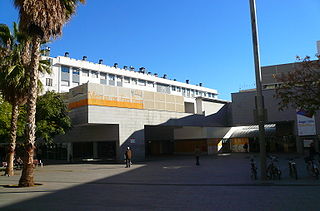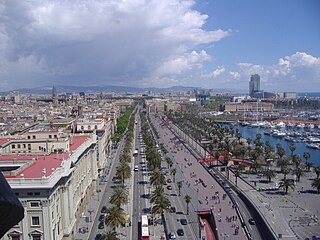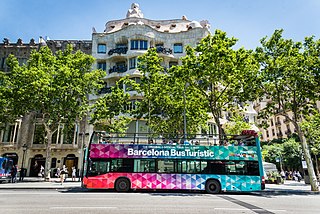
Casa Batlló is a building in the center of Barcelona, Spain. It was designed by Antoni Gaudí, and is considered one of his masterpieces. A remodel of a previously built house, it was redesigned in 1904 by Gaudí and has been refurbished several times after that. Gaudí's assistants Domènec Sugrañes i Gras, Josep Canaleta and Joan Rubió also contributed to the renovation project.

La Seu d'Urgell is a town located in the Catalan Pyrenees in Spain. La Seu d'Urgell is also the capital of the comarca Alt Urgell, head of the judicial district of la Seu d'Urgell and the seat of the Bishop of Urgell, one of the co-princes of Andorra. It is located in the district of Alt Pirineu i Aran and is the most populated town, with 17.4% of the district's population. La Seu d'Urgell and Puigcerdà together have 30% of the population of the area.

Modernisme, also known as Catalan modernism and Catalan art nouveau, is the historiographic denomination given to an art and literature movement associated with the search of a new entitlement of Catalan culture, one of the most predominant cultures within Spain. Nowadays, it is considered a movement based on the cultural revindication of a Catalan identity. Its main form of expression was Modernista architecture, but it also encompassed many other arts, such as painting and sculpture, and especially the design and the decorative arts, which were particularly important, especially in their role as support to architecture. Modernisme was also a literary movement.

Josep Lluís Sert i López was a Catalan architect and city planner.

The Arc de Triomf is a triumphal arch in the city of Barcelona in Catalonia, Spain. It was built by architect Josep Vilaseca i Casanovas as the main access gate for the 1888 Barcelona World Fair. The arch crosses over the wide central promenade of the Passeig de Lluís Companys, leading to the Ciutadella Park that now occupies the site of the world fair. It is located at the northern end of the promenade, facing the Passeig de Sant Joan.

Manlleu is municipality in the comarca of Osona, in the province of Barcelona, Catalonia, northern Spain.

Passeig de Gràcia is one of the major avenues in Barcelona (Catalonia) and one of its most important shopping and business areas, containing several of the city's most celebrated pieces of architecture. It is located in the central part of Eixample, stretching from Plaça Catalunya to Carrer Gran de Gràcia.

Estació de França is a major railway station in the city of Barcelona in Catalonia, Spain.

Passeig de Lluís Companys is a promenade in the Ciutat Vella and Eixample districts of Barcelona, Catalonia, Spain, and can be seen as an extension of Passeig de Sant Joan. It was named after President Lluís Companys, who was executed in 1940. It starts in Arc de Triomf and ends in Parc de la Ciutadella, on Carrer de Pujades.

The Illa de la Discòrdia or Mansana de la Discòrdia[mənˈsanə ðə lə disˈkɔɾði.ə] — "Block of Discord"; Spanish: Manzana de la Discordia — is a city block on Passeig de Gràcia in the Eixample district of Barcelona, Catalonia, Spain. The block is noted for having buildings by four of Barcelona's most important Modernista architects, Lluís Domènech i Montaner, Antoni Gaudí, Josep Puig i Cadafalch and Enric Sagnier, in close proximity. As the four architects' styles were very different, the buildings clash with each other and the neighboring buildings. They were all built in the early years of the 20th century.

Arc de Triomf is a Rodalies de Catalunya and Barcelona Metro interchange complex. It is named after the adjacent triumphal arch of the same name near which it is situated, in the Barcelona district of Eixample in Catalonia, Spain. The Rodalies station is served by Barcelona commuter rail service lines R1, R3 and R4, as well as Girona commuter rail service line RG1 and regional line R12. The Barcelona Metro station is served by TMB-operated line L1.

Fort Pienc is a neighborhood in the Eixample district of Barcelona, Catalonia, Spain. Its name stems from a former military fortification which existed there until the 19th century called Fort Pius, Pienc is an adjective in Catalan meaning related to the name Pius. There has been a strong Chinese presence in the area since the 2000s. The Arc de Triomf is the main attraction in the area, located in Passeig de Lluís Companys-Passeig de Sant Joan, while L'Auditori is an important concert hall. The National Theatre of Catalonia is another of its cultural centres, as is the General Archive of the Crown of Aragon, near Parc de l'Estació del Nord. The General Catalana de Electricidad building is a fine piece of modernisme or local art nouveau architecture. La Monumental is the only extant bullring in the city.

The Cursa de Bombers is an annual road running race over 10 km which takes place in April in Barcelona, Catalonia, Spain.

The 2010 Catalan autonomy protest was a demonstration in central Barcelona on 10 July 2010 against limitations of the autonomy of Catalonia, and particularly against a recent decision of the Spanish Constitutional Court to annul or reinterpret several articles of the 2006 Statute of Autonomy of Catalonia. The number of people taking part in the demonstration was estimated at between 1.1 million and 1.5 million, while Madrid-based newspaper El País estimated the number of demonstrators at 425,000. The mobilisation was described as "unprecedented" by the mayor of Barcelona. The Barcelona daily newspaper El Periódico de Catalunya described it as "without a doubt one of the biggest protest marches that has ever occurred in Catalonia, possibly the biggest". It is thought that the 2012 Catalan independence demonstration involved more people, but this protest brought the dispute to light in the world.

Carrer de Pujades and Passeig de Pujades, before 1900 rendered Pujadas, are respectively a street and a promenade in the Poblenou and Sant Martí de Provençals areas of Barcelona. It's named after the poet and historian Jeroni Pujades, who penned a Universal Chronicle of the Principality of Catalonia in the 16th century. In Ildefons Cerdà's urban plan the street was to be named U street. It starts by Passeig de Picasso and Passeig de Lluís Companys, and runs to the north-east of Poblenou, at Carrer de la Selva de Mar, near Avinguda Diagonal. It borders one of Barcelona's biggest parks, Parc de la Ciutadella and crosses the city's new development district, 22@. Some 19th-century and early-20th-century industrial architecture is still to be found in the area, along with late-20th-century developments, despite their being replaced by newer structures and office buildings.

Public art in Barcelona is a designated group of monuments and outdoor sculptures in the city. The artworks in city's architecture and network of museums, parks, and gardens, put an artistic stamp on the Catalan capital. Public art in the city developed in the 19th century, although the first municipal commission was the 1673 monument to Saint Eulalia in Pedró Square.

National Day for Yes was a gathering in Barcelona on 11 September 2017, the National Day of Catalonia, in support of Catalan independence. It was organized by the Catalan National Assembly (ANC), the main civil society organisations behind the massive pro-independence demonstrations held since 2012.

Barcelona Bús Turístic is a tourist bus service in the city of Barcelona, which in 2012 had 3 routes and a fleet of 74 buses. It is managed by the consortium of Turisme de Barcelona and TMB.

The Institut Nova Història is a Catalan cultural foundation with headquarters in Barcelona committed to revisionist pseudohistorical research. Its members, of which the most prominent is the Catalan nationalist writer Jordi Bilbeny, hold that history has been systematically manipulated by the Spanish state since the 15th century to eliminate the Catalan contribution to world history. The foundation promotes research, study and dissemination through publications, conferences, documentaries and symposia of its vision of Catalan history. in particular the annual "Symposium on the Catalan Discovery of America" in Arenys de Munt. This has led them to create a "history of their own" whose theses, "more or less picturesques ”, are rejected by both scholars and Academia. Alberto Reig Tapia, from University of Rovira i Virgili considers that their members do not make history but "Parody of History"'. Josep Colomer, from Georgetown University, has called them “cartoon satirists” ». The Institut Nova Història claims that major historical figures, including Christopher Columbus, Erasmus, Miguel de Cervantes, William Shakespeare, Leonardo da Vinci, Saint Teresa of Ávila and others were Catalan. It is funded by the Catalan autonomous government, and has received support from Catalan nationalist politicians.






















